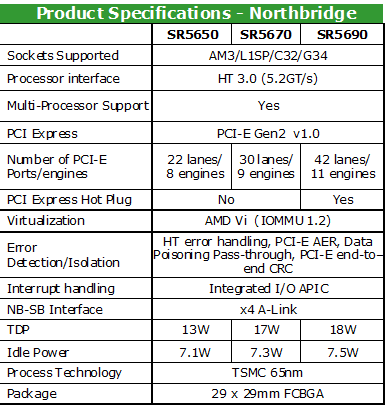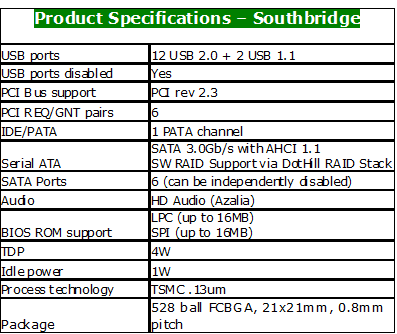AMD's 2010/2011 Roadmap from the IT Professional’s Perspective
by Johan De Gelas on November 23, 2009 12:00 AM EST- Posted in
- IT Computing
At its recent financial analyst day, AMD disclosed processor and platform roadmaps for 2010 and 2011. As the target public consisted mainly of financial analysts, the presentations focused more on AMD’s strategy and competitiveness than on technical accuracy. We had a conference call with John Fruehe and Phil Hughes of AMD and we tried to find out what the new server CPU roadmap means for our readers, the IT professionals who actually configure and buy these servers.
Compared to the mobile and desktop market, AMD is doing relatively well in the server and HPC market. The early delivery of the six-core Opteron (codenamed Istanbul) enabled Cray to build the fastest supercomputer in the world (at least for Q4 2009). It's called the the Cray XT5-HE “Jaguar” with 224162 cores, good for almost 1.76 million GFlops. The Opteron EE made heads turn in the low power cloud computing market, and the six-core Opteron is a good price/performance alternative in the rest of the server world. And last but not least, the 4-socket 84xx Opterons are the unchallenged champions in the quad socket world.
Nevertheless, AMD’s position in the server and HPC market is seriously threatened. An impressive 95 out of the top 500 supercomputers contain Intel's "Nehalem-EP" Xeon 5500 processors. Intel’s star has been rising fast in the HPC market since the introduction of the Intel Xeon 5500. Intel’s Nehalem EX is almost ready to attack the quad socket market. And there's more.
AMD created a very “cool” niche market with the 40W ACP (60W TDP) Opteron EE. Large power limited datacenters bought these CPUs in quantities of a few (and more!) thousands at once. Just a few months ago, Intel also introduced a 45 Watt Xeon L3426 at 1.86 GHz based on their Lynfield core (LGA1156 socket). Considering that AMD’s ACP numbers are rather optimistic and Intel’s TDPs are rather pessimistic, the 8-thread quadcore 1.86 GHz L3426 ($284) makes the six-core 1.8 GHz Opteron 2419EE look expensive ($989). The former can push it’s clock up to 3.2 GHz under single threaded loads, and is thus a really interesting option if your application has a significant part of non-parallel code.
So far AMD has countered Intel’s higher “per core” performance with 50% more cores. Indeed, the six-core Opteron can keep up with the Xeon 5500 in quite a few applications. But Intel is readying a slightly improved six-core version of the Xeon 5500 series called Westmere-EP in the first half of 2010. Being a 32 nm high-K dielectric CPU, the six-core Westmere-EP wil offer about the same power consumption with six-cores under load as the quadcore Xeon 5500 (Nehalem EP). At idle, Westmere-EP will consume less (14 to 22% less leakage). Westmere-EP’s architecture is identical to that of the Nehalem EP, with the exception of a 50% larger L3 cache (12 instead of 8 MB) and support for special AES instructions.
AMD's Answer
It was hardly noticeable but AMD made a historic step forward in September 2009 with the introduction of it’s own server chipsets. For the first time, AMD is a real server platform supplier, in control of both the CPU and chipset. The previous AMD server platform was mostly based on NVIDIA's nForce 3600 Pro. The nForce 3600 gave some system administrators quite a few headaches, especially in combination with VMware’s ESX. VMware’s ESX installed flawlessly on all Intel platforms we have tried so far, but it was unpredictable whether or not an nForce board would work with ESX. Of course, the added value of a tier one OEM is that they sort these things out and offer you a driver + hardware platform that is certified for ESX and others. So you could say that this was a non-issue for HP, SUN and Dell buyers (I have hardly seen any IBM Opteron based servers in the wild). Still, it is good to see that AMD is now completely responsible and in charge of it’s own server platform.


At the moment, the impact of the “Fiorano” or SR56xx chipsets is negligible. Most server vendors are preparing the servers based on the C32 socket and G34 socket and don’t feel like investing in the socket-F server platform which is at the end of its long road. Only Tyan and Supermicron, which focus mostly on the HPC market, offer servers based on the AMD SR5690 chipset right now.










107 Comments
View All Comments
Zool - Thursday, November 26, 2009 - link
The desktop Phenom II X4 925 in 1000 quantities from amd site is 145 USD. The opteron 8300 series (simiral cache and die area than phenon II) lowest priced model 523 USD , highest priced model Quad-Core AMD Opteron 8393 SE is costing 2649 USD.The wafer cost for the 145 USD cpu is same than for the 2649 USD cpu.If the die areas are similar than the actual manufacturing(same machine usage,same workforce, etc) costs should be almost identical.
So now they are selling the Phenom II X4 925 for 145 USD and i asume that they have some margins even on these models. So let we say 25 USD are the margins and 120 USD the costs.
So for the Quad-Core AMD Opteron 8393 SE the margins will be 2529 USD. Now wait a moment biatch. THATS 101 TIMES more than for the almost same Phenom II X4 925. For a average Opteron they get around 50 times more money the same low end desktop. The same story for intel server cpu-s.
No wonder they can SHIT on low cost desktop cpu-s. The whole roadmap is a mess about cores and manufacturing proces for server cpu derivates.
vsary6968 - Thursday, November 26, 2009 - link
Show me the benchmark that the Nehalem-EX beat Magny-Cours. So don't stated something that is not out yet.This is hurting other forum threadjames775 - Tuesday, November 24, 2009 - link
is now up and available at:http://www.amdzone.com/phpbb3/viewtopic.php?f=52&a...">http://www.amdzone.com/phpbb3/viewtopic...amp;star...
Chlorus - Tuesday, November 24, 2009 - link
I'm sure a website titled "AMDZone" will be objective and nonbiased.james775 - Tuesday, November 24, 2009 - link
sure, its unbiased just like this article.http://bit.ly/8BX9UG">http://bit.ly/8BX9UG
happy? =))
james775 - Tuesday, November 24, 2009 - link
http://bit.ly/6Id6y0">http://bit.ly/6Id6y0Zool - Tuesday, November 24, 2009 - link
Huh "The extra integer core (schedulers, D-cache and pipelines) adds only 5% die space".They finaly found out that the amount of owerhead that they add to each execution core which actualy makes the real work ( something like 1/5 of the core logic die size) is not worth duplicate x times with each core.
Maybe if they would make the pipelines much shorter and add only very basic prefetch , decode , branch prediction logic the amount of performance for the transistor budget would be quite shocking.
I mean how much slower would be a amd thunderbird core on 4 GHz to curent single nehalem core.
If u download this cpu test program with the results ( link : http://testcpu.webz.cz/index.htm">http://testcpu.webz.cz/index.htm ) u can compare your result with old cpus. The program is quite old but that means its quite fair too.
A single core wolfdale 3.2 ghz Dhry=10712575
Whet=2372478
Mips=7160629
Mflops=995667
amd athlon 1100 Mhz(22mil transistors) Dhry=2220351
Whet=692956
Mips=2382066
Mflops=300902
Thats around 60% faster wolfdale on same clocks than the 22mil transistor (need to note that the L2 cache was on the cpu board :) )
Just want to say that the several times more complex logic and die size increase gives you quite disapointing results.
So someone out there could finaly make real low power high frequency cpu-s and dont chase cpu cores.
freezervv - Wednesday, November 25, 2009 - link
"The program is quite old but that means its quite fair too.""Just want to say that the several times more complex logic and die size increase gives you quite disapointing results."
Umm, isn't that why people in the real world use efficient ISA extensions?
Zool - Wednesday, November 25, 2009 - link
"Umm, isn't that why people in the real world use efficient ISA extensions?"Pentium 3 had already SSE with 128bit registers. Upgrading to SSE3 wouldnt be a big deal. Intel atom supports everything up to SSSE3.
Zool - Wednesday, November 25, 2009 - link
"The program is quite old but that means its quite fair too."The problem is that that testing old cpu-s to curent ones is only working in old programs that have minimal external bandwith requirments or some minimal command promt tests. If u would test the amd 1100 MHz and the core duo wolfdale in for example Cinebench10 the diference would be much bigger. The amd 1100 cant keep up the 10+ times external memory bandwith in core2 duo. The situation would be same in real world aplications, with such slow external bandwith the old cpu-s are very slow but that doesnt mean the IPC is that much slower.
I just want to say that amd and intel had several years of time to release a normal low power cpu without the insane die overhead of current cpu-s. And they did a big nothing. It could reach 70-80 percent of core performance for fraction of current die area.(the rest could be gained trough 30% frequency increase :) )
The curent cpu designs increase IPC by 20-30 percent trough insane amount of compications and die size when they could just increase frequency by that amount with the right cheap design.